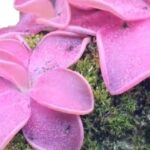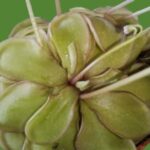As an Amazon Associate, this site earns commissions from qualifying purchases. For more details, click here.
Pinguicula lutea is found throughout the southeastern United States, mostly in open pine woods, marshes and bogs. This warm temperate pinguicula is well known for its bright yellow flowers. The plant is not difficult to cultivate in a garden, but it has a few specific requirements that set it apart from other butterworts.
Plant pinguicula lutea in equal parts peat and silica sand under direct sunlight. The temperature should be between 68-85 F (20-30 C) in summer and 50-60 F (10-15 C) in winter. The soil has to be moistened lightly with good airflow.
Pinguicula Lutea Care Sheet
| Soil | 1:1 peat moss and perlite |
| Water | Keep soil damp, pure water only |
| Light | Direct sunlight, preferably outdoors |
| Food | Flies, gnats, bugs, spiders, freeze dried worms, fish betta pellets |
| Temperature | 68-85 F (20-30 C) |
| Humidity | 50% |
| Dormancy | No, but growth slows in winter |
| Propagation | Seeds |
Soil
Pinguicula lutea thrives in acidic, poor soil. The ideal pH rating is 5.0 to 6.0. Do not use ordinary potting soil or fertilizers. Any potting media rich in nutrients should never be used on carnivorous plants.
The ideal potting soil is 50/50 silica sand and peat moss. Other media such as vermiculite, perlite and sphagnum moss may also be used. In most cases a 1:1 ratio is enough.
The soil should be moist but lighter compared to other butterworts. With some variants you can even let it dry out a little. This will depend on the health of your plant as well as the humidity and temperature. As long as there is moisture in the air, a lightly damp soil will be enough.
Most p. lutea are sold as seeds so you have to buy and prepare the soil. Fortunately there are a lot of premixed potting media available like Soil Sunrise Carnivorous Mix. Because 50/50 peat moss and silica sand are used with other butterworts, they are easy to come by.
Pot Container
A mature pinguicula lutea can reach up to 6 inches across, so a large container is required. You can use a plastic pot as long as it is deep and wide enough.
You can grow several p. lutea together in one large pot. To do this, make sure each plant has sufficient room to grow. Keep this in mind if you are growing seeds as this plant is larger than other butterworts.
P. lutea cannot be planted in the ground because it needs specific types of soil media. You can however, grow it in a pot in your garden. These plants are ideal for outdoor cultivation provided the conditions are sufficient.
If you are going to buy p. lutea online chances are the plant is not potted. Decide how many of these you want to grow together so you can figure out the right size. A pot several inches wide will do for a single p. lutea. While its flowers can grow several inches, its roots are fairly small.
Water
Use pure water so the soil stays moist but not soaked. The tray method may be used in lieu of overhead watering, but reduce the amount in winter.
Tropical butterworts like pinguicula Aphrodite prefer moist soil, but with p. lutea you can use less water. The potting media should still be damp but not completely soaked. This is necessary to help the plant grow especially if you start with seedlings.
P. lutea does not have a dormant state in winter, but development will slow. You may minimize watering, just enough to lightly mist the soil. When spring arrives, new growth will start to appear and you can resume normal watering. Use only Deer Park Spring Water or other pure water sources.
You can use the tray method to make this task easier. Get a container and fill with 1 to 1.5 inches of water. Let the potted p. lutea stand in the water. You can add as many plants as the container can hold, but give each plant a few inches of space.
The more butterworts you put in the tray, the faster the water will dissipate. Increase the volume incrementally to see how it affects the plants. Do not pour too much into the tray as pinguicula roots are fragile and susceptible to decomposition.
Light
Direct sunlight is essential for pinguicula lutea. Sunlight from a windowsill may not be enough as this plant thrives when grown outdoors.
Warm temperate butterworts need more sun compared to tropical species. P. lutea prefers full, direct sunlight even during summer. As long as the temperature does not top 85 F (30 C) you can leave the plant under full light.
Find a sunny location in your garden or patio. Anywhere will do as long as the plant has unfiltered access to sunlight. You can tell the plant is doing well by how vivid its flowers are. Its ability to produce mucus will not be affected even under full light.
Artificial lights. P. lutea does not grow as fast under indoor grow light. However you may use these during winter when development slows. For its growth season in spring and summer however, you should take the plant outdoors to get sunlight. If it is too hot, bring your pinguicula indoors and set it on a windowsill.
Temperature
During summer the ideal temperature range for pinguicula lutea is 68-85 F (20-30 C). For winter it is 50-60 F (10-15 C). Do not expose this plant to winter frost or extreme heat.
Its winter hardiness zone is 11, so if you live there p. lutea should be fine outdoors. If the heat index goes a few degrees higher in summer, partially cover the plant. Do this only if it is over 85 F for prolonged periods, otherwise just leave the plant in the light.
Do not leave p. lutea outside if the temperature drops below 50 F. As you may have guessed, this plant does not handle winter climate well. Mulching is not enough to keep the plant alive outdoors during winter. Just bring it inside until spring arrives. Use indoor lights in winter and follow the natural day/night pattern.
Whether you grow p. lutea outdoors or in a greenhouse, try to keep the temperature within the suggested. This has a direct effect on its growth and development.
Humidity
A healthy p. lutea does not need high humidity levels to produce mucus on their leaves. Typical butterworts grow in 50% humidity and that is fine with pinguicula lutea. But the plant will still grow in low humidity provided there is enough sunlight.
You do not have to monitor the humidity rate all the time. Just keep the plant in the recommended temperature range, there should be no problems.
Signs of low humidity are dry leaves, faded colors and lack of appetite. The best solution is to sit the plant in water. Use the tray method and add 1.5-2 inches of water. The normal limit is 1.5 inches but with humidity low, you can increase it.
Too much humidity is bad for pinguicula too. The worst case scenario is root rot, which can be a real problem with butterworts as their roots are very small. The solution is to increase sunlight exposure or reduce watering.
Nutrition and Feeding
Pinguicula lutea does not have to be fed if grown outdoors (as it should be). Its mucus-covered leaves will lure insects and supply the plant with nutrients.
You have probably heard of fertilizers being used to grow butterworts. While you are not supposed to fertilize the soil, you can apply a small amount on the leaves. Fertilizing butterworts can lead to faster growth, but it is not necessary for p. lutea.
For one, this variant is naturally large and second, fertilizer is like food for the plant. If you combine insects, fertilizer and glucose, it might be too much. As long as your pinguicula is growing, there is not need for fertilizers.
Dormancy
Pinguicula lutea does not need a dormant phase. The plant retains its green color the entire year and will not survive winter frost.
If it never drops below 50 F in your area, you may keep p. lutea outside. Otherwise, grow the plant indoors during winter. During the cold, keep it in a place where the temperature is around 50-60 F (10-15 C).
These plants slow in winter but do not go dormant. As the season draws to a close, expect new carnivorous leaves to appear and flowers to bloom. When this occurs, you can slowly restore your normal spring care routine.

My fascination with carnivorous plants began many, many years ago with Venus Fly Traps. Now I am more than happy to impart what I know with other enthusiasts and those who are curious about meat eating plants.



